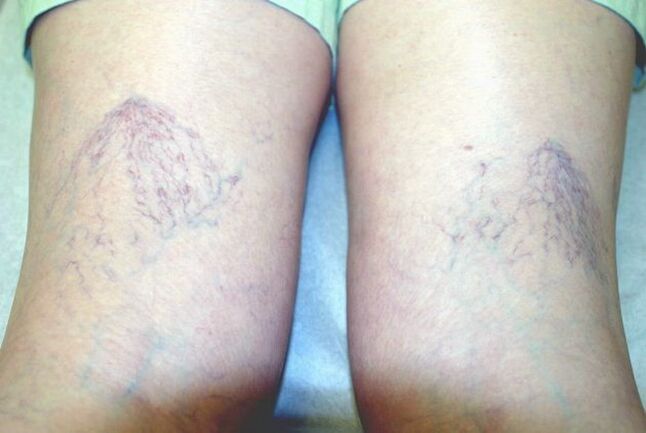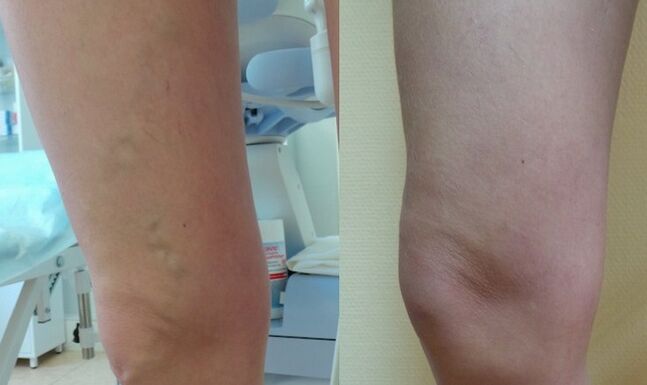Reticular extension varicose veins lead to the appearance of bluish vascular tissue in the lower part of the leg. Therefore, among the public, this form of varicose veins is often called "cosmetic" or "reticular".
What does the phrase "reticular varicose veins" mean?
Some doctors do not consider reticular varicose veins to be a disease. They urged to regard it as a cosmetic defect that does not pose a threat to the health of patients. Men with mild forms of varicose veins, as a rule, do not focus on it.
In Western countries there is no special term "lower reticular varicose veins", experts do not think what it is.
Other doctors disagree on this issue. Some experts are convinced that reticular varicose veins are the result of a lack of venous duct valves, therefore, the disease must be treated without delay. Otherwise, patients with cosmetic varicose veins will experience serious complications. After all, the condition is unlikely to be limited to the defeat of superficial veins, after a long time, varicose veins can spread to the channels in the venous system.

Symptoms of the disease
There are the following signs of reticular or cosmetic varicose veins:
- Feeling of heaviness in the limbs.
- Swollen.
- Increased fatigue.
- The appearance of a blue snare. It is formed of enlarged superficial small -caliber vessels and capillaries.
- Cramps in the calf muscles.
- Pain in dilated vein localization.
In the advanced stages of the disease, external bleeding may occur.
The cause of the disease
Lower reticular varicose veins occur under the influence of the following reasons:
- Take contraceptives to prevent unwanted pregnancies.
- Overweight.
- Pregnancy and childbirth.
- Genetic predisposition.
- Inactive lifestyle.
Hard physical work often leads to the appearance of vascular patterns on the limbs. With excessive load on the legs, the venous wall gradually loses its elasticity, and blood circulation in the body worsens.
Diagnosis of the disease
If you suspect the presence of reticular varicose veins, the patient is interviewed. Doctors pay attention to the following conditions:
- The nature and localization of pain.
- The patient's working condition.
- The presence of concomitant diseases.
- Patient lifestyle.
- The presence of a hereditary predisposition to varicose veins.

Then the specialist proceeds with a visual examination of the patient. During the procedure, the doctor not only examines the spider veins, but also checks the condition of the skin near them: the presence of seals or edema in the affected area. For example, varicose veins on the face often occur in the eye area. In this case, the doctor may see a light purple bag under the eye. When viewed from a closer distance, a network of small veins and capillaries is clearly visible. With lip varicose veins, small nodules of rich red color with a slight blue appear.
Other methods of diagnosing the disease are also used. For example, ultrasound examination helps assess the condition of venous valves, revealing the presence of blood clots.
MRI in the presence of reticular varicose veins was performed only according to individual indications.
With varicose veins, general clinical studies are also conducted. This includes mainly blood and urine tests. Thanks to general clinical studies, it is possible to assess the possibility of developing thrombophlebitis and thrombosis. They help to choose the right tactics for further treatment.
Classification of diseases
There is a special classification of reticular varicose veins. Its proponents, in addition to the six main stages, also distinguish the zero stage of the disease. It is almost asymptomatic. Only a few patients experience a feeling of heaviness in the legs.
In the first stage of the disease, a thin tissue consisting of small vessels appears through the skin. The next stage is the expansion of the blood vessels. In the third stage of the disease, edema occurs, the veins protruding clearly above the surface of the skin. In the fourth stage of the disease, the color of the skin in the dilated venous area changes. It may turn dark brown. At a later stage, trophic ulcers may begin to form. In the sixth stage of the disease, the patient's condition deteriorates dramatically. With the help of medications, it is impossible to overcome trophic ulcers.
Methods of disease treatment
In the treatment of reticular varicose veins, the following methods are used:
- Taking medications.
- Exercise.
- Make a decoction based on medicinal plants.
- Perform laser coagulation or microphlebectomy.
It is almost impossible to completely get rid of obvious cosmetic defects with the help of drugs, folk remedies or therapeutic exercises. Therefore, treatment of the disease with minimally invasive methods is practiced (microphlebectomy, sclerotherapy).

Laser coagulation and microphlebectomy for varicose veins
Microphlebectomy is performed with a local anesthetic. The essence of this medical manipulation is to pull the veins damaged by varicose veins outwards. During microphlebectomy, the skin is first pierced with a thin medical hook. The remaining traces are almost invisible to the peeping eye. Microflebectomy is not accompanied by discomfort, the patient quickly returns to normal life. She was advised to wear compression socks.
When performing sclerotherapy, a special solution is injected into the vessel. The device is attached to the vascular wall, as a result, all damage is healed. The duration of the recovery period varies from three to ten days (depending on the well -being of the patient). The patient should wear a bandage that fits the limb. It is applied to the puncture site. The number of procedures depends on the severity of the disease. The duration of the treatment session varies from 5 to 60 minutes. It is recommended to stop smoking, hot baths and alcoholic beverages within three days after sclerotherapy.
Drug use
In the treatment of reticular varicose veins, drugs are used in various dosage forms:
- pill.
- Capsules.
- Ointment.
- cream.
- Gel.
Medications have a good effect on the superficial canals of the legs. Reticular varicose veins are usually treated with the following medications:
- Venotonic. The preparation eliminates discomfort in the legs, prevents the appearance of seizures and the occurrence of trophic ulcers.
- Drugs containing rutoside. The drug helps reduce capillary permeability, helps eliminate edema. With the help of special drugs, the vascular wall is strengthened. Drugs containing rutoside are used not only in the treatment of varicose veins. They eliminate the symptoms of hemorrhoids, thrombophlebitis, venous insufficiency.
Benefits of physical therapy
Laser therapy has anti-inflammatory effects on the body. Thanks to the procedure, the cholesterol content in the body is reduced, tissue swelling is reduced. Laser therapy helps patients to abandon expensive medications intended for the treatment of reticular varicose veins.
It is necessary to highlight the following advantages of laser therapy:
- Positive changes can be seen after the second procedure.
- In about 70% of cases, the affected vein decreases in size by up to 3 mm after the first session.
After the session, the patient may experience pain. In some cases, doctors prescribe non-steroidal anti-inflammatory drugs to patients to eliminate unwanted side effects.
Magnetic stimulation involves exposure to low -frequency magnetic impulses. After the procedure, the condition of the vessel muscle tissue improves, and blood circulation improves. The average duration of a pulse magnetotherapy session is 20 minutes. After the procedure, the swelling of the feet is significantly reduced.
Folk remedies for varicose veins
Treatment with folk remedies involves both the manufacture of decoctions for internal use, and the use of ointments intended for external use.
The main benefits of alternative medicine include:
- The relatively low cost of ingredients found in folk remedies;
- Ease of fund preparation. To use the recipes of traditional medicine practitioners, you do not need to have special skills.
- Improve the general well -being of patients.
| Folk medicine | Cooking scheme |
|---|---|
| Garlic ointment | This tool normalizes blood circulation in the body. To prepare the ointment, you need to mix garlic, grated on a fine grater, and butter in a ratio of 1: 2. The mixture is applied to the affected area before bedtime. Cover the top with polyethylene or parchment paper. It is fixed with an elastic bandage or a thin scarf. In the morning, the compress is removed, the feet are washed thoroughly |
| Compressed sour milk | To prepare the compress, a napkin made of gauze is soaked in sour milk. The agent is applied to the affected area. From above, the affected area is carefully covered with polyethylene, the limbs are wrapped with a warm scarf. Compressed should be kept no more than 30 minutes. This procedure can be repeated up to three times a day. |
| Colored hops | It is necessary to pour 30 grams of medicinal plants with 400 ml of boiling water. The tool was asserted for two hours. You need to take 50 ml of drink three times a day. The duration of the course of treatment is 14 days. |
| Rinse feet with cold water | During the procedure, water is used, which should be slightly cooler than room temperature. When rinsing, you can add a solution of medicinal plants into the water: nettle, lemon balm, apple cider vinegar. Do not wipe your feet after the procedure. They must dry naturally |
| Kalanchoe ointment | To prepare the ointment, you need to take 0. 5 kg of fresh plant leaves. Kalanchoe is washed with water and placed in a clean glass. The plant is poured with alcohol in a ratio of 1: 1. Ointment must be infused for at least 10 days in a dry room protected from sunlight. The product is applied to the limbs with gentle massaging movements. Kalanchoe eliminates the painful sensation in the legs. The duration of the course of treatment is at least three months |
Special diet
With the presence of reticular varicose veins, the following foods are usually excluded from the daily menu:
- Spicy food.
- candy.
- Delicious spices.
- Strongly brewed coffee.
- sweet pastry.
- Orange vegetables.

The patient's diet must be supplemented with the following products:
- Freshly squeezed juice.
- Dishes that add berries: viburnum or rose hips.
- green.
- fruits.
- Dishes that contain grains such as rye or wheat.
The diet of a person suffering from reticular varicose veins must contain foods rich in vitamins A, E, C and B. This includes, first of all, fermented milk drinks, nuts, citrus fruits, sea fish dishes.
Exercises for reticular varicose veins
Therapeutic gymnastics increases the outflow of lymph from the affected ducts. You can do this simple exercise:
- The patient should stand upright.
- He should slowly raise his heels and return to the starting position. While doing this exercise, it is forbidden to tear socks from the floor.
Therapeutic gymnastics helps increase the strength of the venous wall. The only contraindication to exercise is the presence of trophic ulcers on the legs.
In the supine position, "scissors" and "bike" exercises are performed. They must be done for at least two minutes (each).
Precautions
Many people have heard the hacked phrase that "disease is easier to prevent than to cure. " No one will doubt the truth of this statement.
There are the following preventative measures that reduce the chances of developing reticular varicose veins:
- Avoid coffee, cigarettes and strong alcoholic beverages.
- Wear compression products. It is recommended to wear it every day, once a day: in the morning or evening.
- Rejection of intense physical activity.
- Frequent visits to the pool.
- Perform special exercises designed to prevent the appearance of "cosmetic" varicose veins.




































